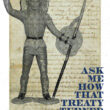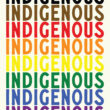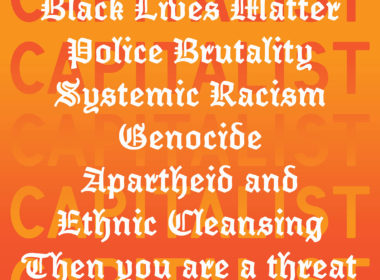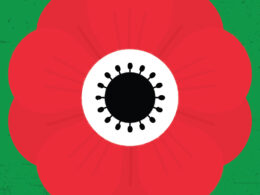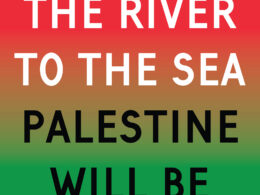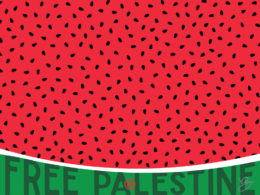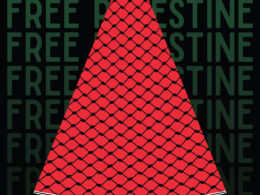Handala
Title: Handala (Naji Salim Hussain Al-Ali)
Subject: Iconic symbol of Palestinian identity and defiance
Created: 2024
Medium: Graphic Design
Software: Adobe Illustrator CC
Dimensions: 36″x48″
Concept: Digital recreation of the drawing of Handala by Naji Salim Hussain Al-Ali (1938-1987)
Naji Salim Hussain Al-Ali
Naji Salim Hussain Al-Ali (Arabic: ناجي سليم العلي Nājī Salīm al-‘Alī; born c. 1938 – 29 August 1987) was a Palestinian cartoonist, noted for the political criticism of the Arab regimes and Israel in his works. Al-Ali is best known as the creator of the character Handala, a personification of the Palestinian people that has become [a] prominent symbol of Palestinian nationalism and resistance.
One of the best-known cartoonists in the Arab world, and celebrated as the greatest Palestinian cartoon artist, Al-Ali drew over 40,000 cartoons, often reflecting Palestinian and Arab public opinion and offering sharply critical commentaries on Palestinian and Arab politics and political leaders. On 22 July 1987, while outside the London offices of al-Qabas, a Kuwaiti newspaper for which he drew political caricatures, Al-Ali was shot in the neck and mortally wounded. He died five weeks later in Charing Cross Hospital.
– Wikipedia.org, Naji al-Ali
Article
“Handala (Arabic: حنظلة, romanized: Ḥanẓala), also known as Handhala, Hanzala, or Hanthala, is a prominent national symbol and personification of the Palestinian people.
The character was created in 1969 by political cartoonist Naji al-Ali, and first took its current form in 1973. Handala became the signature of Naji al-Ali’s cartoons and remains an iconic symbol of Palestinian identity and defiance. The character has been described as “portraying war, resistance, and the Palestinian identity with astounding clarity”.
The name comes from Citrullus colocynthis (Arabic: حنظل, romanized: Ḥanẓal), a perennial plant local to the region of Palestine which bears a bitter fruit, grows back when cut and has deep roots.
Handala’s impact has continued in the decades after al-Ali’s 1987 assassination; today the character remains widely popular as a representative of the Palestinian people, and is found on numerous walls and buildings throughout the West Bank (notably as West Bank Wall graffiti art), Gaza and other Palestinian refugee camps, and as a popular tattoo and jewellery motif. It has also been used by movements such as Boycott, Divestment and Sanctions and the Iranian Green Movement.”
– Wikipedia.org, Handala
Symbolism
“Handala’s age – ten years old – represents Naji al-Ali‘s age in 1948 when he was forced to leave Palestine and would not grow up until he could return to his homeland: Al-Ali wrote that:
Handala was born 10 years old and he will always be 10 years old. It was at that age that I left my homeland. When Handala returns, he will still be 10 years old, and then he will start growing up.
His posture, with his turned back and clasped hands symbolise the character’s “rejection at a time when solutions are presented to us the American way” and as “a symbol of rejection of all the present negative tides in our region.”
Handala’s ragged clothes and standing barefoot symbolise his allegiance to the poor.
Al-Ali described Handala as “the symbol of a just cause”:
He was the arrow of the compass, pointing steadily towards Palestine. Not just Palestine in geographical terms, but Palestine in its humanitarian sense—the symbol of a just cause, whether it is located in Egypt, Vietnam or South Africa.“
– Wikipedia.org, Handala
Download the 8.5″x11″ print (.pdf), Print – Handala (Naji Salim Hussain Al-Ali).
Wallpaper
Download this design to your mobile and laptop device by visiting the Wallpapers page.
Close-ups



Alternate Version

Free Palestine
Free Palestine is a series of artworks by Ihanktonwan Dakota artist David Bernie that addresses the policy of Genocide against the Palestinian community.
Creative Commons License
This work by David Bernie is licensed under a Creative Commons Attribution-NonCommercial-NoDerivatives 4.0 International License. You may download, share, and post the images under the condition that the works are attributed to the artist.


